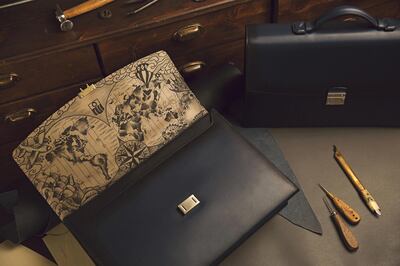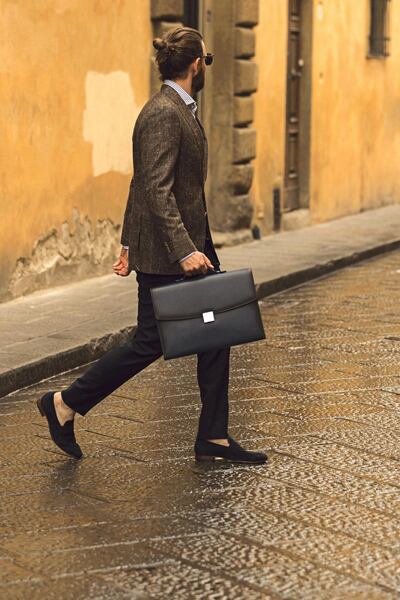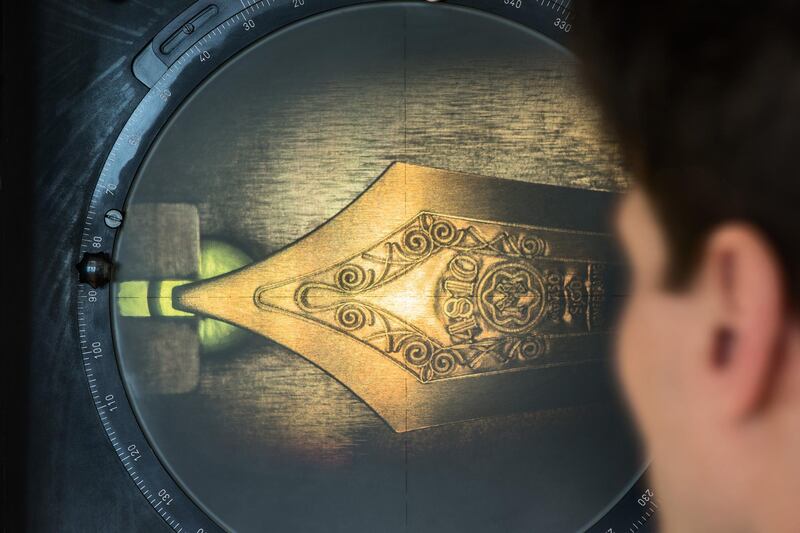“Bauhaus, David Bowie and the Rolling Stones.” These are the influences that have shaped Zaim Kamal’s aesthetic, he tells me with a smile. It’s perhaps not what you would expect from the global creative director of Montblanc, a 112-year-old heritage brand best known for its exquisitely crafted fountain pens. But Kamal, with his unhurried manner, melodious voice, grey hair and slim frame habitually clad in black, is nothing if not unexpected.
“I am a child of the 1970s and I was very much influenced by that era,” he continues. “So it’s all a little bit, for lack of a better word, edgy. I grew up with rock bands and electric guitars; my mother used to go to Studio 54 – that’s the world I come from. So I think I tend to look at things from a different angle.”
He has developed a knack for presenting things outside of their usual context. This has translated into projects such as the Montblanc Secret Adornment Tattoo collection – briefcases that feature secret, hand-drawn tattoos by Mo Coppoletta on the inside of their flaps. “I said I wanted to do a tattoo on leather,” Kamal recalls. “They asked why. What does a tattoo have to do with leather? I said it’s the idea of writing with ink on a surface… of using the idea of writing, of making your mark, but in a different way.”

Kamal started his career as a fashion designer, graduating from Central Saint Martins in 1991, in the midst of a major recession. "There were no jobs – everybody went bust. We were these highly trained, highly motivated designers, and we just wanted work. Any job," he reveals. Any job ended up being an internship with Vivienne Westwood. "She literally taught us how to create something out of nothing," he recalls. "It takes two metres of fabric to create a jacket. At the time, there wasn't money for two metres of fabric, so we used to go to the bins and get the offcuts – they were between 90 centimetres and one metre wide, and so we had to be very clever with our pattern-cutting. There were all these little things, of understanding how not to waste anything, of being aware of what you do, of not being precious about it."
Although born in Pakistan (into a conservative family that must have baulked at the idea of him studying fashion), Kamal has called the British capital home for more than 30 years. "I have always loved London, since I was a child," he says. "I grew up in Pakistan, but London had everything that I wanted. It was creative; it was big; it was crazy; okay, the food sucked, but London has an energy that you will not find anywhere else in the world. The weather sucks, but when the sun shines, the city glows.
“You can sit in central London and you will see every trend – everything that is going to happen, that has happened, that is happening – walk past you in a single day. If you want to see what the world is going to be, go to Camden Lock on a Saturday; just sit there on the bridge and let the world go by. You will see everything that’s in the making.”
It was perhaps fated that he would end up at Montblanc, since he has always been surrounded by the brand’s creations: his grandfather used to collect writing instruments and Kamal, himself, has long been a fan of the brand’s iconic Meisterstück pen.
“I have used a Meisterstück to draw forever, because it is so simple. You could write with it; you could draw with it; you could lick your finger and then shade with it. You could do everything with it. It was this idea of having this piece that was always there and felt good in your hand and that became a companion, almost. And I’ve been given the reins to create this product that can inspire other people in a similar way,” he explains.

Kamal works across the company’s four categories – writing instruments, leather goods, watches and accessories – and assures me that, contrary to popular opinion, men can multitask. “I’ll be sitting in Florence working on a leather line with the design team and then I’ll get an email from the watch designer, saying I’m working on this watch and I’ve changed something; can you have a look? So I am in this constant whirlwind of change and I have to say, it is amazing,” the creative director says.
He is committed to addressing a new millennial or Gen Z audience that, he says, is "rediscovering the beauty of craftsmanship". With this also comes the opportunity to tell old stories in a new way to an audience that might not have heard them before. The brand's Writers Edition, Patron of Art, Muses Edition and Great Characters writing instruments, which have in the past paid tribute to people such as Marilyn Monroe, William Shakespeare, John F Kennedy, The Beatles and Miles Davis, are a case in point.
"When we launched The Beatles writing instrument, for instance, we were in Abbey Road, where they recorded everything, and the writing instrument is literally based on The Beatles microphone. When people asked why, I explained that it's because The Beatles were famous for harmonising and they all harmonised around this one microphone. It was the same when we did the Miles Davis edition. They asked about a swirl on it, and I explained that it was a tornado – he has a very specific way of blowing his horn, and he always said he got this very special breath from a tornado that he was exposed to as a child in Kansas. Suddenly, you are opening up a whole new world. This is the transmission that we do."
Earlier this year, the brand unveiled an homage to Homer, the ancient Greek author of the Odyssey and Iliad, with a pen featuring references to a Trojan horse and the black-figured pottery that is often decorated with scenes from Homeric poetry.You might assume that trying to convey such sentiments on the most minuscule of canvases – the nib and barrel of a pen, or the face of a watch – would be frustrating, but Kamal insists otherwise. "When you work with writing instruments or watches, it's so much in the detail, and the more you go into the details, the freer you get. On the writing instruments, we are talking about tenths of millimetres that can make a difference. We are talking about a story that is wrapped around a tube; it has a three dimensionality that has to work. I find that very exhilarating – to be able to convey all of that. I'm often very humbled that we have people who can actually genuinely translate these things. They know that by pushing boundaries we all learn new things. I always say to my team: 'If you start at 70 per cent, you'll end up at 50 per cent. If you start at 130 per cent, if you are lucky, you'll get 90.' So I tell them: 'Push; don't be scared.'
“Keith Richards always used to say: ‘Do things for the right reasons or don’t bother doing them at all, we all like to think of ourselves as being so super-important, and that’s why I love working for Montblanc, because it’s not about ego. It’s just about doing stuff, about creating,” Kamal concludes.
_________________________
Read more:
Would you pay Dh120,500 for a barbecue?
From cowboy staple to high-fashion favourite: the evolution of the bolo tie
Upscale leather house MCM embraces street style
_________________________












